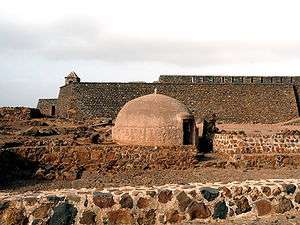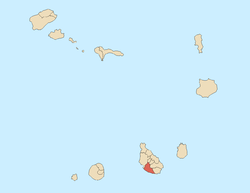Fort Real de São Filipe
| Cidade Velha, Historic Centre of Ribeira Grande | |
|---|---|
| Name as inscribed on the World Heritage List | |
|
View over the old fort of São Filipe from Cidade Velha | |
| Type | Cultural |
| Criteria | ii, iii, vi |
| Reference | 1310 |
| UNESCO region | Africa |
| Inscription history | |
| Inscription | 2009 (33rd Session) |



Forte (or Fortaleza) Real de São Filipe or simply Cidadela is an abandoned fort located in the city of Cidade Velha in the south of the island of Santiago, Cape Verde, it is situated on Achada de São Filipe in which the fort is named after.
It is located 120 meters above sea level, it was the first fortification in Cape Verde and is the most important. The fort offered a system of defense and protection to the city and consisted of lesser forts including Forte de Presídio located near the beach, Forte de Santo António (St. Anthony), Forte de São Joãao dos Cavaleiros (Knights of Saint John) and Forte de São Veríssimo, it had two batteries, one in the west in Forte de São Brás (St. Blas) and Forte de São Lourenço (St. Anthony).
The fort overlooks Ribeira Grande de Santiago on the left, the city, the surrounding countryside and the nearby southern mountains of the island.
History
Located in an isolated location along the Atlantic, the settlement of Ribeira Grande had no defense before[1] The fort plans began during the Philippine Dynasty in November 17, 1585 after assaults by English corsair Sir Francis Drake (as part of the Capture of Santiago) with a work to defend the city from pirates. Work started n 1587 and finished in 1593 in charge by the military engineer João Nunes and traces by architect Filippo Terzi.
In 1712, the city and fort was ruined by French corsairs commanded by Jacques Cassard in the Cassard expedition. It was rebuilt in the mid 18th century.
Restorations were made starting in the 20th century, between 1968 and 1970 and recently in 1999. The recent one was recorded in a renovating plan of Cidade Velha which was started by the Cape Verdean Ministry of Culture under the coordination of the Portuguese architect Siza Vieira with resources responsible by the Spanish International Cooperation Agency.
Archeological excavations were recently done in the older barracks and the captain general's house.
Along with the fort, the city became an UNESCO World Heritage Site, one of the first in Cape Verde on June 26, 2009.
About the fortress
The fortress is built in a trapezoidal form with walls out of stone, fully diagonal bastions and vertices in east and west separated by curtains and two half-bastions in the north and south. In the northwest, the wall with 480 palms high was used for defense.
The front of the fort has two doors: the main located in the southwest wall facing the city to the southwest. The lower part of the wall was used as a governor's house (around the south bastion and close to São Gonçalo (St. Gunnar) chapel. The square part once featured 18 caliber artilleries.
Panoramic view

See also
- Forte da Achada
- Fortim da Ilha do Fogo
- Portuguese Empire
- List of World Heritage Sites in Africa
Notes
- ↑ Bobo, Francisco J. G. de Sousa (2000). Técnica, engenharia e artilharia na Cidade Velha. V. A.. Cabo Verde: fortalezas, gente e paisagem. Bilbao: Agencia Espanhola de Cooperação Internacional. p. 109-110.
Further reading
- Nunes, António Lopes Pires. Dicionário de Arquitetura Militar (Military Architecutral Dictionary). Casal de Cambra: Caleidoscópio, 2005. p. 264. ISBN 972-8801-94-7
- Pereira, Daniel A.. Marcos Cronológicos da Cidade Velha (Chronological Markings of Cidade Velha).
- Pereira, Daniel A.. Importância histórica da Cidade Velha (Ilha de Santiago, Cabo Verde) (Historic Importance of Cidade Velha). Praia: IBN, 2004.
External links
| Wikimedia Commons has media related to Fortaleza Real de São Filipe. |
Coordinates: 14°55′05″N 23°36′36″W / 14.918°N 23.61°W

